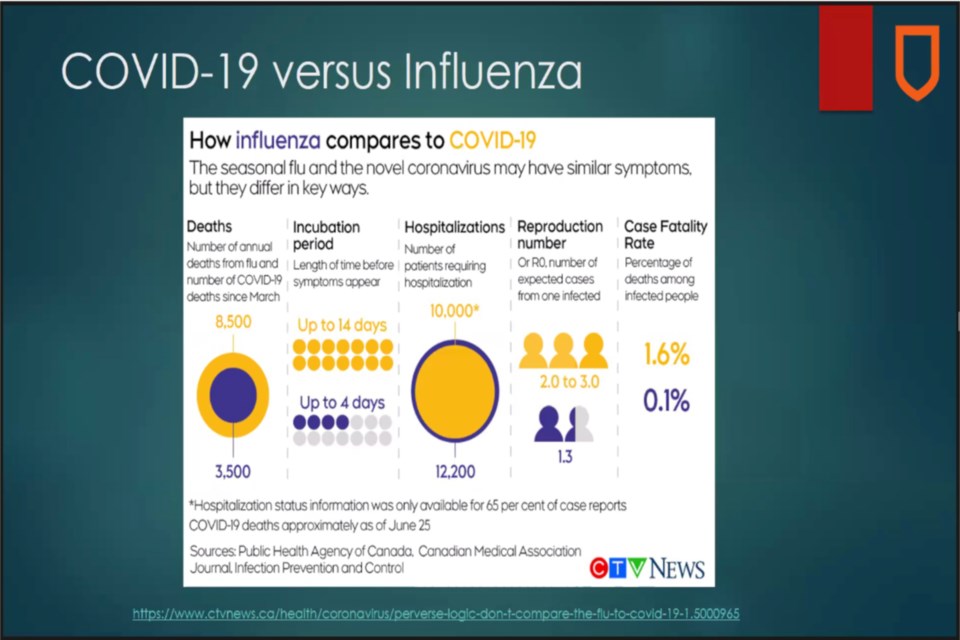ATHABASCA — Since the beginning of the COVID-19 pandemic, an avalanche of information, misinformation and disinformation coming from all angles has made it exceedingly difficult to know who and what to believe.
Science Outreach – Athabasca presented Dr. Shauna Zenteno, a microbiologist and dean of the Faculty of Science and Technology at Athabasca University (AU) Nov. 19, to speak about the current pandemic, reinforce truth and debunk myths to about 30 people who attended through Zoom where she provided a wealth of information and took questions from the audience.
“One of the biggest (myths) is that COVID-19 was engineered in a lab in China; there's been no evidence to prove that it was engineered in a lab in China,” said Zenteno. “So, when scientists look at sequences, they are able to tell usually if a virus has been engineered and if we think about the number of scientists, ethical scientists, across the world that have seen this genome and seeing the sequence, it's pretty safe to say that it was not engineered in a lab.”
Myths are hard things to dispel though as the same conspiracy theories make their way around the Internet, but Zenteno debunked the biggest ones — yes, it is worse than the flu; it is not true that the survival rate is 99.9 per cent, that has been getting lower and lower; yes you do need to wear a mask; no hydroxychloroquine is not an effective treatment; the increase in cases is due to increased exposure, not more testing; and no, herd immunity will not protect people if the virus is left to spread.
“With COVID-19, there's too much to risk to let it run rampant in a population,” Zenteno said. “So, Sweden has tried to do this, but unfortunately, Sweden's had a pretty high death toll as a result. In order for us to manage our healthcare system and take care of everybody in the population, herd immunity is best achieved through vaccination rather than letting it spread.”
Zenteno added that spraying bleach or alcohol all over your body is dangerous and does not kill viruses already in your body. They can be used to disinfect surfaces like door handles or counter tops, but not your skin.
“(Bleach) will not kill COVID in your body, it's incredibly toxic to do that,” said Zenteno.
She also warned that pandemics may become more and more frequent if humans do not stop wreaking the environment, noting it is estimated there are 827,000 undiscovered viruses that exist in mammals and fowls that can infect people.
“Future pandemics are becoming increasingly inevitable. Researchers say as human activities influence climate change and biodiversity loss as it is known, diseases passed from animals to humans, or zoonotic diseases, are rising,” she said. “It is predicted that future pandemics will happen more frequently, spread more rapidly, and do more damage to the world economy and kill more people unless there is a transformative change globally dealing with infectious diseases.”
And as for your pets, yes, they can get COVID-19. Cats are more likley to get it than dogs, but other than an outbreak at a mink farm resulting in the culling of thousands of minks, there have not been widespread reports of animals dying from the virus.
“Interestingly enough, cats are very susceptible to COVID-19; some tigers and lions tested positive at the Bronx Zoo and domestic cats are very susceptible, they can actually become sick with it and even transmit the infection,” Zenteno said. “(Research) says it's very unlikely though, that pets could transmit at all to humans.”
Zenteno recommends those infected stay away from pets and wash their hands before and after touching their pet.
You can watch the entire presentation and discussion, including more on myths, vaccines, politics and pandemics and how effective masks are on Science Outreach — Athabasca’s YouTube channel at: https://www.youtube.com/watch?v=gp9Uzt5gKZQ.
Heather Stocking, TownandCountryToday.com
Follow me on Twitter: @HLSox
Read more from TownandCountryToday.com



